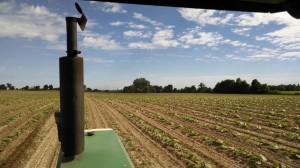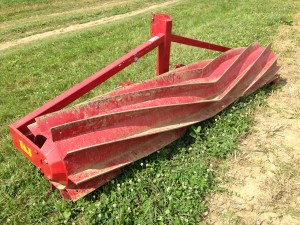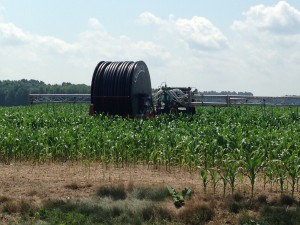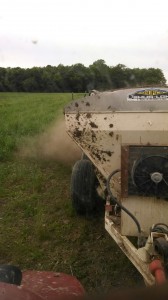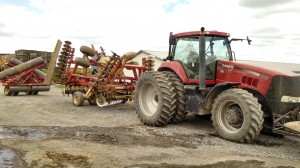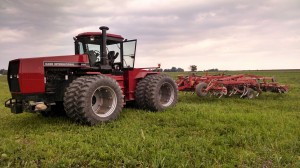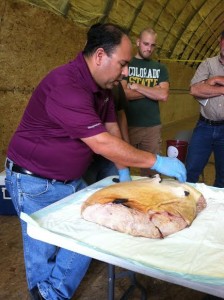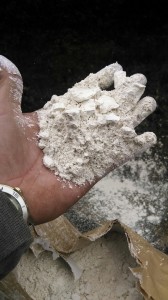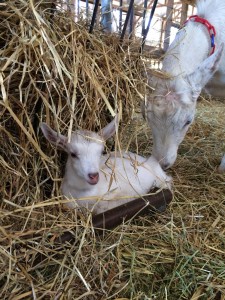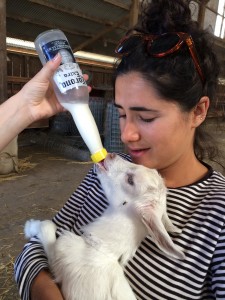I had an amazing time in California last week and couldn’t have asked for a better experience! As I mentioned two weeks ago, we were in Delano sensing two different table grape vineyards, one of which was already being harvested. That Friday we sensed a merlot J. Lohr vineyard in Paso Robles, which was one of my favorite places we visited. It is in the hills, rather than the valley, and even though California is in the middle of a severe drought and everything is brown, it was still beautifu l! On Saturday we sensed a petite sirah Gallo vineyard. Seeing the management and quality of these vineyards was amazing; they were trellised and maintained almost perfectly.
l! On Saturday we sensed a petite sirah Gallo vineyard. Seeing the management and quality of these vineyards was amazing; they were trellised and maintained almost perfectly.
The sensors we were using were Crop Circle canopy sensors produced by Holland Scientific that measure the vegetative index. We had two that we attached to an ATV or tractor to get two different readings from the vines (photo to the left). The sensors were also hooked up to a data logger, along with a GPS. As we drove down the rows of the vineyard the sensors would collect the data and the GPS would keep track of the location, which allows the data to be compared throughout the vineyard and exact locations of data points to be recorded.
I also attended the NGWI (National Wine and Grape Initiative) conference last Monday. The morning was spent in the vineyard at the UC Davis experimental station where a researcher from Carnegie Mellon talked about his research on nondestructive yield estimates (photo to the right). He has created an imaging system t hat takes photos at set intervals that can be used to estimate the yield. The rest of the day was spent listening to other researchers talk about their projects. The most educational aspect for me was learning about the funding and grant writing that goes into the projects, which is something I have known about, but listening to the discussion first hand was interesting.
hat takes photos at set intervals that can be used to estimate the yield. The rest of the day was spent listening to other researchers talk about their projects. The most educational aspect for me was learning about the funding and grant writing that goes into the projects, which is something I have known about, but listening to the discussion first hand was interesting.
The meeting was finished off with a wine reception and dinner at Louis M Martini wine cellar in Napa. It was one of the most delicious dinners I have ever had and in one of the most unique locations. How many people can say they have dined by candle light in a wine cellar surrounded by giant oak barrels? The reception allowed me to talk with several different people and make invaluable connections that will hopefully open doors for me in the future. The trip as a whole cemented my interest in the field, and with my undergraduate education coming to an end, it has gotten me thinking about potential job opportunities and options in the wine and grape industry.
We were also able to have some fun on the trip! Friday afternoon was spent driving up the coast, and we stopped several times to take photos of the view. One of the spots we stopped at had a trail that we followed down to a rocky shore line where there were tidal pools with anemones a nd clams. Farther up the coast, in Monterey, we stopped at a beach and waded in the Pacific Ocean. On Sunday we drove into San Francisco, where we walked part way across the Golden Gate Bridge, and rode the cable car down to the fisherman’s wharf where we ate lunch at the Boudin sourdough bakery. San Francisco is definitely a city I would love to go back to with more time to explore!
nd clams. Farther up the coast, in Monterey, we stopped at a beach and waded in the Pacific Ocean. On Sunday we drove into San Francisco, where we walked part way across the Golden Gate Bridge, and rode the cable car down to the fisherman’s wharf where we ate lunch at the Boudin sourdough bakery. San Francisco is definitely a city I would love to go back to with more time to explore!
The end of last week was spent counting the mites on the hop leaves Kim collected for me on Tuesday while I was gone. There has definitely been an increase in TSSM, and the mites aren’t found everywhere, but rather in little pockets around the hopyard. I still haven’t found very many predatory mites and Tim has suggested that maybe I release more at the opposite end of the hopyard, as some of the TSSM numbers are above the 5-10 mites per leave threshold for July. Next week I will have a better update for you, as I will be discussing my project with Tim and Greg, my faculty supervisor for the project on Wednesday.
The two vineyard photos and the photo of the coast were taken by Terry Bates


